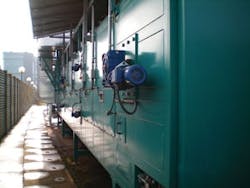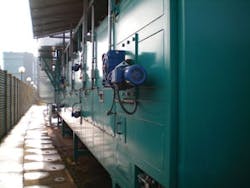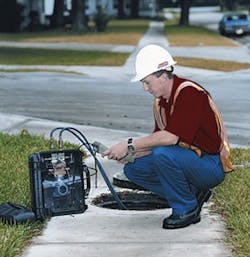By Mark Prouty
The Town of Perryville, MD, located on the Susquehanna River at the head of Chesapeake Bay, was having water problems. Its water treatment plant, built in the 1970s and withdrawing water from the Susquehanna River, was unable to meet the standards of new regulations for potable water. A growing town of 3,000, Perryville needed more treatment capacity, improved treatment performance, and emergency water storage to serve the expanding needs of the community.
The original Susquehanna Water Filtration Plant was a standard sedimentation-filtration plant. It used metal salts and polymers for coagulation/flocculation and upflow contact clarifiers for sedimentation. After sedimentation, the water was filtered using standard rapid sand filters. Daily backwash of the filters was discharged into the river through an NPDES permitted outlet. Solids collected during sedimentation were pumped into tanker trucks and hauled to the wastewater plant for conditioning, dewatering, and disposal.
Due to a small clearwell/chlorine contact tank, the operators had to rely on dosing chlorine to the raw water at the sedimentation tanks before the filters to assure sufficient detention time for disinfection. Recently developed EPA regulations require water purveyors to discontinue such a practice because of the possibility of creating harmful disinfection by-products.
The plant treats approximately 450,000 gallons per day in the summer and 300,000 in the winter. The raw water from the Susquehanna River is extremely variable in quality. The intake point in the river is below the Conowingo Dam and the water is extremely muddy during high-stage releases. In addition, surface water temperatures vary to extremes throughout the year and influence the treatment technologies that were considered during the review of alternatives.
Developing a Solution
Retained to develop a solution, URS began by performing an analysis of treatment methods to reach the new regulatory criteria while using existing components and structures. A critical consideration was the need to terminate both discharge of backwash waters to the river and hauling residuals by truck. Also, a computer model of the distribution system was created to assess the placement and size of water storage facilities and transmission main piping. This was done to optimize the performance of distribution system operations and to provide sufficient water for fire fighting or other emergency needs.
It was determined that membrane technology could be the most effective means of improving the treatment plant and reaching the town's goals. It was felt that no pre-sedimentation would be necessary, so the existing settling tanks could be retrofitted as contact tanks to provide the required chlorine contact time. The need for pre-chlorination and the potential health risks associated with disinfection by-products would be eliminated. However, membrane treatment had never been used on surface water in the State of Maryland.
Pilot Testing
A pilot test of the membranes was initiated to demonstrate that the proposed system could meet all the requirements of a stand-alone treatment process without additional measures such as pre-sedimentation while at the same time reducing cost. During piloting, river water was tested at various turbidities and temperatures. Clay was even added to the raw water during testing to simulate extreme suspended solids levels, as this was a significant concern. The simulation exceeded previous raw water turbidity spikes encountered during multiple gate openings at the dam, demonstrating that the membrane system could continue processing water and meet finished water turbidity goals by monitoring transmembrane pressures and modifying cycles. All testing results were positive and final design was begun.
Membrane System
The proposed membrane system includes an enhanced coagulation and flocculation stage to agglomerate suspended solids in the raw water. This is followed by filtration through membranes containing 0.035 – 01 micron pore openings. The hollow fiber ultrafiltration membranes are assembled into modules that are immersed directly into a tank of raw water and provide a physical barrier against pathogens.
The system operates under a low-pressure vacuum that is induced within the hollow membrane fibers by a connection to the suction side of a permeate pump. Air is supplied in the tank at the bottom of the membrane module to create turbulence which scrubs and cleans the outside of the membrane fibers. The air also oxidizes iron, manganese, and other organic compounds in raw water and keeps collected solids in suspension within the tank until being routinely drained into the backwash holding tank.
Membranes can benefit engineers when aged treatment systems require retrofit because of their small footprint, which allows for the possible use of existing tankage. The membrane backwash methods also reduce the necessary volume of water for each backwash since there is no need to fluidize a filter bed to release trapped soils as is customary in traditional sand filters. Backwash waters are now sent to equalization/ thickening tanks which allow for the recycling of low turbidity supernatant water.
System improvements
The backwash improvements include a pump station and force main that allow the Town to pump the thickened residuals through their existing sewer system to the wastewater treatment plant and eliminate the need for trucking residuals. The new residual handling system increases regularity and sustainability of operations at the facility.
An additional improvement at the water treatment facility was the replacement of the aging water intakes. The original intake system consisted of two 20-inch pre-stressed concrete pipes extending 750 feet out into the river. Two 10-foot-long cylindrical screens were on ends of each intake pipe and were buried beneath riprap armament. The intakes were designed for 0.8 MGD and served to provide water to the raw water pump station. Since the intakes were inaccessible from land or water, maintenance was a difficult task.
The new membrane system operates under a low-pressure vacuum that is induced by a connection to the suction side of the permeate pumps.
The town experienced several operational problems with the intakes. Principally, river debris and sediment often clogged the screens making it difficult to supply water through the pipes at adequate flow rates. To resolve the problem, two pre-cast concrete intake structures with multiple supply pipes and isolation slide gates were installed in the Susquehanna.. The pipe orientations extend downstream to take advantage of the river bottom morphology and minimize the build-up of silt. Located within the vaults are 48-inch-diameter stainless steel wedge wire intake screens with 0.5-mm openings. The clogging potential is greatly reduced by enclosing both screens within the two pre-cast structures.
The surface area of each screen is designed for 2.5 mgd with velocities of less than 0.5 fps to comply with federal regulations for the protection of fish. The top of the vaults extend above the high-water elevations to allow access for operators. In addition, an air purge line was placed on the screens to be used in the event that debris accumulates on the surface and cannot be removed by backpulsing the lines with the raw water pumps.
The design of the plant and distribution systems included the use of materials and components that have substantial longevity. The system was designed for an initial flow of 1 mgd, but that can easily be doubled in a modular fashion. The new facility provides a system that contributes to sustained quality, needs little additional equipment, reduces the need for operations and maintenance, and is "fail safe."
Goals Met
The goals set during planning were met. The plant can cost effectively reach treatment requirements for potable water under the new guidelines by the use of membrane technologies. Existing sedimentation tanks were reused as chlorine contact tanks and sand filter tanks were reused as membrane tanks. The discharge permit for backwash was eliminated and solids are more easily managed. Sizing for all piping and tanks will accommodate future conditions and the new million gallon elevated storage tank meets the fire protection and emergency storage requirements into the future.
The Town of Perryville is now positioned to meet the needs of its residents while allowing for growth in this attractive region of the country. WW
About the Author:Mark Prouty is a Senior Project Manager with URS Corp. in Wilmington, DE. He has provided water and wastewater design services to municipalities and industry for over 30 years.
More WaterWorld Current Issue Articles
More WaterWorld Archives Issue Articles





